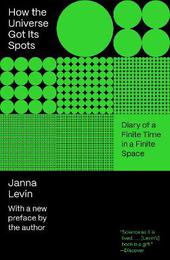
|
How the Universe Got Its Spots: Diary of a Finite Time in a Finite Space
Paperback / softback
Main Details
| Title |
How the Universe Got Its Spots: Diary of a Finite Time in a Finite Space
|
| Authors and Contributors |
By (author) Janna Levin
|
| Physical Properties |
| Format:Paperback / softback | | Pages:224 | | Dimensions(mm): Height 203,Width 133 |
|
| Category/Genre | Geography |
|---|
| ISBN/Barcode |
9780691232270
|
| Classifications | Dewey:523.1 |
|---|
| Audience | | Undergraduate | | Professional & Vocational | | Postgraduate, Research & Scholarly | |
|---|
| Illustrations |
68 b/w illus.
|
|
Publishing Details |
| Publisher |
Princeton University Press
|
| Imprint |
Princeton University Press
|
| NZ Release Date |
21 March 2023 |
| Publication Country |
United States
|
Description
Mixing memoir and visionary science, a leading astrophysicist's groundbreaking personal account of her life and ideas Is the universe infinite or just really big? With this question, cosmologist Janna Levin announces the central theme of this book, which established her as one of the most direct, unorthodox, and creative voices in contemporary science. As Levin sets out to determine how big "really big" may be, she offers a rare intimate look at the daily life of an innovative physicist, complete with jet lag and the tensions between personal relationships and the extreme demands of scientific exploration. Nimbly explaining geometry, topology, chaos, and string theory, Levin shows how the pattern of hot and cold spots left over from the big bang may one day reveal the size of the cosmos. The result is a thrilling story of cosmology by one of its leading thinkers.
Author Biography
Janna Levin is professor of physics and astronomy at Barnard College of Columbia University and director of sciences at Pioneer Works, a nonprofit cultural center in Brooklyn. Her books include Black Hole Blues, Black Hole Survival Guide, and a prize-winning novel, A Madman Dreams of Turing Machines. She presented NOVA's Black Hole Apocalypse and has delivered iconic stories at The Moth and TED.
Reviews"[A] lovely, utterly original book. . . . This intimate account of the life and thought of a physicist is one of the nicest scientific books I have ever read-personal and honest, clear and informative, entertaining and difficult to put down."---Alejandro Gangui, American Scientist "Gorgeously written."---Mary Carmichael, Newsweek "Highly original. . . . Few scientists are capable of putting their understanding and experiences into words as effectively."---Peter Coles, Nature "Science as it is lived. . . . [Levin's] book is a gift."---Corey S. Powell, Discover "Gives a personal resonance to scientists' attempts to understand the mysteries of the universe." * Washington Post * "Levin not only tours the wilder reaches of cosmology, but she also bares her soul." * New Scientist * "If the universe is infinite, then its possibilities are infinite as well. But in How the Universe Got Its Spots, the astrophysicist Janna Levin insists that infinity works as a hypothetical concept only, and that it is not found in nature."---Lauren Porcaro, New Yorker "Levin unpacks the technicalities with a skill honed from giving many lectures on the subject, and it is fascinating to read. . . . A book to be applauded."---Andrew Crumey, The Scotsman "[A] touchingly personal account."---Jim McClean, The Herald (Glasgow) "Levin interweaves enlightening insights into the most profound enigmas of space, time and infinity with reflections on her struggle to balance her personal and professional lives. The result suggests a blend of Zen and the Art of Motorcycle Maintenance and The History of Time."---Dan Kincaid, Arizona Republic "The intellectual-emotional balance, and the finely tuned prose, are what makes this different from the very many other books on cosmology. And Levin has found an interesting way to do this; the book is in the form of letters to her mother." * Globe and Mail * "How the Universe Got Its Spots is a genuine attempt to break down barriers, both intellectual and emotional, between scientists and their wished-for audience."---Ken Grimes and Alison Boyle, Astronomy
|